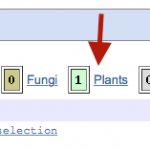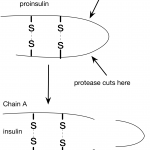insulin
Image of cave dwelling Mexican tetra By Citron via Wikimedia Commons
Mexican tetra (Astyanax mexicanus) are a fascinating example of divergent evolution. Over time, some of these freshwater river fish washed into caves where they continue to live. With perpetual darkness, these cavefish have lost their ability to see along with their skin pigmentation. Oxygen and food are also hard to come by in the caves. In fact, the cave dwelling fish may go for months without eating as they wait for seasonal floods to deliver foods. Dr. Cliff Tabin (Harvard Medical School) recently presented his…
I know this is not a comparative physiology topic, but this article caught my attention as I know I just ate a rather high fat meal last week for Thanksgiving and I plan to do the same throughout the holiday season.
Insulin does more than just lowering blood sugar by increasing its uptake into tissues. It can also increase blood flow to the hippocampal region of the brain to help cognitive function. This area of the brain is important in memory formation and spatial orientation. A new study published in the American Journal of Physiology - Endocrinology and Metabolism used…
Image of sheep from Wikimedia Commons
Insulin is a major hormone responsible for regulating blood sugar. Its main function is to lower sugar by increasing glucose uptake into muscle and fat cells. Insulin resistance is the hallmark of type 2 diabetes and occurs when tissues in the body are not able to respond to insulin resulting in sustained elevations in blood sugar, also known as hyperglycemia.
An alternative mechanism for lowering blood sugar is muscle contraction as it stimulates a pathway distinct from insulin in the muscles to cause glucose uptake from the blood. Exercise…
I was very impressed by the graduate and undergraduate students who presented their research at the Scholander poster competition sponsored by the Comparative and Evolutionary Physiology section of the American Physiological Society this afternoon. I am sure the winner of the competition will be very difficult to select.
Some highlights included:
Bridget Martinez, graduate student at the University of California - Merced whose research focused on hormonal changes that occur with fasting in elephant seal pups. In mammals, food deprivation leads to lower…
Pull a spaghetti noodle out of a box of pasta and take a look. It's long and stiff. Try to bend it and it breaks. But fresh pasta is pliable. It can fold just like cooked noodles.
When students first look at an amino acid sequence, a long string of confusing letters, they often think those letters are part of a chain like an uncooked spaghetti noodle. Stiff and unbending, with one end far from the other.
Molecular modeling apps let us demonstrate that proteins are a bit more like fresh pasta.
If we apply rainbow colors (Red Orange Yellow Blue…
Sometimes when you go digging through the databases, you find unexpected things.
When I was researching the previous posts on insulin structure and insulin evolution, I found something curious indeed.
Human insulin, colored by rainbow. Image from the Molecule World iPad app by Digital World Biology.
I wanted to find out how many different organisms made insulin, so I used a database at the NCBI called Blink. Blink is a database of protein blast search results. Using Blink can save you lots of time because…
In my last post, I wrote about insulin and interesting features of the insulin structure. Some of the things I learned were really surprising. For example, I was surprised to learn how similar pig and human insulin are. I hadn't considered this before, but this made me wonder about the human insulin we used to give to one of our cats. How do cat and human insulin compare?
It turns out, that all vertebrates produce insulin, even frogs and zebra fish. Human preproinsulin is only 110 amino acids long and even human and fish insulin are pretty similar…
Sucrose
Molecules of sucrose tore apart in their bellies letting glucose course free in their veins.
Luckily for us, a system evolved long ago to capture that glucose and minimize it's potential for damage. Removing sugar from the blood and sequestering it in liver, fat, and muscle cells, minimizes the harm that might result if sugars were free to bind to proteins and our bodies were stressed by trying to flush excess glucose out of our system.
This holiday season, we give thanks for insulin and the biotech companies like Genentech that cloned the human gene and began to…
Scientists use a 'gene gun' to insert a gene from a flowering plant called rockcress into the cells of wheat seeds. The genetically modified wheat became more resistant to a fungus called take-all, which in real life can cause "a 40-60% reduction in wheat yields."
T-cells from six HIV+ patients were removed from their bodies, treated with a zinc-finger nuclease designed to snip a gene out of the cell's DNA, and put back in the patients. Removal of the gene mimics a naturally occurring mutation which confers resistance to the HIV virus. But only 25% of the treated cells showed…
Image of a grizzly bear at Yellowstone National Park from http://free-naturewallpaper.com/nature-images/animals/bears/Grizzly-at-…
I was so excited to see a story featuring grizzly bears (Ursus arctos horribilis) in the Wall Street Journal yesterday. The article was about how Dr. Kevin Corbit at Amgen Inc. is studying grizzly bears in the Bear Center at Washington State University to learn more about obesity. The 12 animals living in the facility were either rescued from places where they were captured after getting too close to humans or were born at the facility. Dr. Corbit was quoted in…
A new study from Science Translational Medicine (DOI:10.1126/scitranslmed.3006534) presents data showing that tauroursodeoxycholic acid (TUDCA), a compound isolated from the bile of bears, may actually slow the development of type 1 diabetes (in mice at least). It is thought to work by reducing stress responses from the endoplasmic reticulum in the insulin-producing beta cells of the pancreas which become defective in type 1 diabetes. Use of bear bile is common in traditional Chinese medicine, and at one time led to near-extinction of black bears in China. Fortunately, synthetic versions of…
Image of beagle from www.dogbreedinfo.com/beagle.htm
Diabetes is characterized by high blood sugar. The cause of high blood sugar differs for people with type 1 versus type 2 diabetes. For type 1 diabetics, the pancreas produces little or no insulin, the hormone responsible for lowering blood sugar. For type 2 diabetics, tissues in the body are not responsive to insulin, termed insulin resistance, resulting in persistently elevated blood sugar. Muscle tissue is the main site of glucose disposal in the body and therefore, the main site of insulin's action.
Researchers from Universitat…
People diet for many reasons - to fit into clothes, to look more attractive, or for the sake of their health. But to improve their memory? It's an interesting idea, and one that's been given fresh support by Veronica Witte and colleagues from the University of Munster in Germany.
Witte found that elderly people who slash the calories in their diet by 30% were better able to remember lists of words than people who stuck to their normal routine. It's the first experiment to show that cutting calories can improve human memory at an age when declining memory is par for the course.
The benefits…






